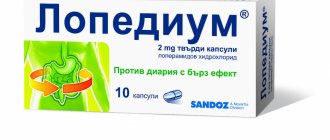Omeprazole is an antisecretory drug used in the treatment of peptic ulcers and erosive-inflammatory diseases of the upper gastrointestinal tract. Acting at the molecular level, Omeprazole suppresses the production and reduces the damaging effect of hydrochloric acid on the gastric mucosa, restores the pH of gastric juice and reduces its activity after meals.
The drug is used for stomach ulcers
By provoking a persistent decrease in acidity, the drug creates optimal conditions for the destruction of H. pylory, which is often the cause of gastritis and peptic ulcers. It is worth noting that Omeprazole becomes active only when it enters the acidic environment of the stomach.
Omeprazole not only significantly improves the well-being of patients, causes a rapid regression of diseases of the stomach and/or duodenum caused by acid disorders, and reduces the likelihood of relapse and the development of complications. Its action begins within 1 hour after ingestion and continues throughout the day.
Pharmacodynamics
Omeprazole inhibits the enzyme H+-K+-ATPase (“proton pump”) in the parietal cells of the stomach and thereby blocks the final stage of hydrochloric acid synthesis. This leads to a decrease in the level of basal and stimulated secretion, regardless of the nature of the stimulus. After a single oral dose of the drug, the effect of omeprazole occurs within the first hour and continues for 24 hours, the maximum effect is achieved after 2 hours. In patients with duodenal ulcer, taking 20 mg of omeprazole maintains intragastric pH = 3 for 17 hours. After stopping the intake of the drug, secretory activity is completely restored after 3–5 days.
Interaction
Long-term use of the drug at a dose of 0.02 g 1 time / day. in combination with Theophylline , Naproxen , caffeine , Piroxicam , Metoprolol , Diclofenac , ethanol , Propranolol , Cyclosporine , Quinidine , Lidocaine and Estradiol does not lead to a change in their plasma concentration .
when used concomitantly with antacids .
Omeprazole affects the bioavailability of any drug, the absorption of which depends on the acidity value (iron salts, for example).
Pharmacokinetics
Omeprazole is rapidly absorbed from the gastrointestinal tract, Cmax in plasma is achieved in 0.5–1 hour. Bioavailability is 30–40%. Plasma protein binding is about 90%. Omeprazole is almost completely metabolized in the liver. T1/2 - 0.5–1 hour. Excreted mainly by the kidneys in the form of metabolites. In chronic renal failure, excretion decreases in proportion to the decrease in creatinine clearance. In elderly patients, excretion decreases and bioavailability increases. In case of liver failure, bioavailability is 100%, T1/2 is 3 hours.
Contraindications
Omeprazole should not be taken in the following cases:
- individual intolerance to the components of the drug;
- pregnancy and lactation;
- age up to 5 years;
- severe forms of liver and kidney failure (with caution);
- malignant tumors of the digestive tract;
- gastrointestinal infections (Omeprazole may increase their reproduction);
- osteoporosis (Omeprazole leaches calcium from bones).
As for osteoporosis, in extreme cases, the attending physician may prescribe complex therapy, including calcium supplements and vitamin D.
The drug should not be taken during pregnancy
Omeprazole also helps reduce the acidity of gastric juice. In this regard, it is not prescribed for gastritis with low acidity and atrophic gastritis.
Side effects
In rare cases, the following usually reversible side effects may occur.
From the digestive system: diarrhea or constipation, nausea, vomiting, flatulence, abdominal pain, dry mouth, taste disturbances, stomatitis, transient increase in the level of liver enzymes in plasma; in patients with previous severe liver disease - hepatitis (including jaundice), impaired liver function.
From the nervous system: headache, dizziness, agitation, drowsiness, insomnia, paresthesia, depression, hallucinations; in patients with severe concomitant somatic diseases, in patients with previous severe liver disease - encephalopathy.
From the musculoskeletal system: muscle weakness, myalgia, arthralgia.
From the hematopoietic system: leukopenia, thrombocytopenia; in some cases - agranulocytosis, pancytopenia.
From the skin: itching; rarely (in some cases) - photosensitivity, erythema multiforme, alopecia.
Allergic reactions: urticaria, angioedema, bronchospasm, interstitial nephritis and anaphylactic shock.
Other: blurred vision, peripheral edema, increased sweating, fever, gynecomastia; rarely - the formation of gastric glandular cysts during long-term treatment (a consequence of inhibition of hydrochloric acid secretion, which is benign and reversible).
Directions for use and doses
Orally, with a small amount of water (the contents of the capsule must not be chewed).
Duodenal ulcer in the acute phase - 1 caps. (20 mg) per day for 2–4 weeks (in resistant cases - up to 2 capsules per day).
Gastric ulcer in the acute phase and erosive-ulcerative esophagitis - 1-2 caps. per day for 4–8 weeks.
Erosive and ulcerative lesions of the gastrointestinal tract caused by taking NSAIDs - 1 caps. per day for 4–8 weeks.
Eradication of Helicobacter pylori - 1 caps. 2 times a day for 7 days in combination with antibacterial agents.
Anti-relapse treatment of gastric and duodenal ulcers - 1 caps. per day.
Anti-relapse treatment of reflux esophagitis - 1 caps. per day for a long time (up to 6 months).
Zollinger-Ellison syndrome - the dose is selected individually depending on the initial level of gastric secretion, usually starting from 60 mg/day. If necessary, the dose is increased to 80–120 mg/day, in which case it is divided into 2 doses.
Overdose
The drug has a fairly low level of toxicity, but with an independent increase in dosage, above the permissible doses for a particular disease, signs of increased side effects will appear.
The main symptoms will be impaired visual function, excessive agitation, confusion, drowsiness, headaches, excessive sweating, nausea and vomiting, arrhythmia, tachycardia, anorexia
If symptoms of overdose appear, immediately consult a doctor for qualified help.
There is no specific treatment, hemodialysis is not effective. Treatment is aimed at eliminating symptoms of overdose and maintaining normal laboratory values. If necessary, gastric lavage and activated charcoal are prescribed.
Interaction of Omeprazole with other drugs
- Omeprazole slows down or enhances the elimination of drugs that are oxidized in the liver (warfarin, diazepam, phenytoin).
- Plasma concentrations of atazanavir and nelfinavir may be significantly reduced when coadministered with omeprazole.
- Plasma concentrations of saquinavir and ritonavir increase to 65-70% when taken with omeprazole, which does not affect the tolerability of therapy in HIV-infected patients.
- The bioavailability of drugs whose elimination depends on acidity (iron salts) can change both up and down.
- Combination with drugs that reduce the acidity of gastric juice reduces the effect of omeprazole.
- St. John's wort preparations, when taken with omeprazole, can accelerate its breakdown, reducing the concentration of the active substance in the blood plasma.
- When using omeprazole with methotrexate, an increase in the concentration of methotrexate in the blood may be observed.
- When taking methotrexate in high doses, you should stop taking omeprazole to avoid side effects.
- When taking omeprazole with amoxicillin or metronidazole, there are no side effects.
- With long-term administration of 20 mg of omeprazole with lidocaine, caffeine, and ethyl alcohol, no changes in plasma concentrations were observed.
- The interaction of proton pump inhibitor drugs with antacids has not been analyzed.
- The attending physician should monitor patients taking phenytoin concomitantly with omeprazole, as a reduction in phenytoin dosage may be necessary.
- The use of cilostazol and omeprazole at a dosage of 40 mg 1 time per day can lead to an increase in the maximum concentration of cilostazol by 20-30%.
- When taken with clopidogrel, there may be an increased risk of blood clots in the coronary vessels of the heart.
- When omeprazole and tacrolimus are taken together, there is an increase in the plasma concentration of tacrolimus.
Omeprazole analogues
Analogues -
These are medicines that contain one active substance and differ in the components of additional substances that regulate the rate of absorption, excretion and reduce the side effects of the original drug. Their effect has been officially proven and tested.
Which is better Omeprazole or Omez?
Omez is a generic drug and does not have major differences in composition and pharmacological action with Omeprazole, however, Omez contains lactose in its excipients, which should be taken into account by people with lactose intolerance or hypolactasia. Also, Omez includes more excipients that reduce absorption and slow down the rate of reaching maximum concentration in the blood plasma.
Omez is produced in India, and Omeprazole is produced in Russia.
You will not notice a significant difference when using the original and the generic, except that the side effects, which may be more pronounced when using Omeprazole, will be slightly smoothed out when using Omez.
Both drugs are available only with a doctor's prescription.
Which is better Omeprazole or Rabeprazole?
Both drugs are proton pump inhibitors. Rabeprazole is recognized as the “gold” standard in the treatment of GERD due to its high rate of decrease in gastric secretion, which lasts up to a day with a small dosage compared to other proton pump drugs. Rabeprazole relieves pain from heartburn faster (3-4 days of treatment) than Omeprazole (5-6 days of treatment). As well as inflammatory and erosive changes in the mucous membrane of the esophagus were eliminated during treatment with Omeprazole on days 18-25, Rabeprazole on days 14-30. When Rabeprazole is discontinued, there is no sudden withdrawal syndrome or increased acidity in the stomach; it slowly recovers over 5-6 days.
Which is better Omeprazole or Famotidine?
When choosing between these two drugs, preference is given to Omeprazole, since it turns out to be more effective in treating gastric ulcers, but it also has a serious side effect in the form of the body getting used to the drug and reducing its effect on the body. In this case, the drug Omeprazole is replaced with Famotidine. Famotidine has a mechanism of action that is different from Omeprazole and is classified as an H2-antihistamine.
Famotidine is produced in the form of tablets of 20 and 40 mg.
Currently, Famotidine has faded into the background, since it affects only H2-histamine receptors and acid production in the stomach continues thanks to acetylcholine and gastrin, which are inhibited by Omeprazole.
These drugs may be co-administered when taken with antacids.
Which is better Omeprazole or Emanera?
The active substance of Emanera differs from Omeprazole - Esomeprazole. The effect after using Emanera occurs within 1-2 hours after taking one capsule. The drugs are used to treat ulcers of the stomach, esophagus and GERD. Emanera also acts as a preventive medicine for long-term use of NSAIDs and conditions with increased acid production in the stomach.
The drug Emanera is able to accumulate in the gastrointestinal mucosa and is released only when the secretion of hydrochloric acid increases.
Which is better Omeprazole or Ranitidine?
They have different mechanisms of action, but the main pharmacological effect remains the same. Ranitidine is less effective in combating hyperacidity. Ranitidine develops the body's resistance to the main substance and requires a constant increase in the dose of the drug.
Ranitidine acts for 9-12 hours and is used 2-3 times a day, regardless of the filling of the stomach and the time of meal; Omeprazole is enough to be taken once a day on an empty stomach.
Ranitidine is used for allergic reactions to the components of Omeprazole and insufficiency of the therapeutic effect of Omeprazole.
Which is better Omeprazole or Esomeprazole?
Its absorption is significantly lower than Omeprazole, since it is almost half destroyed by liver enzymes and does not reach the cells of the gastric mucosa. The use of Esomeprazole for GERD is more effective.
Which is better Omeprazole or Nolpaza?
The main substance of Nolpaza is pantoprazole sodium. The medicinal effect appears after 3 hours from the moment of administration, which is significantly lower than that of Omeprazole - 30 minutes. The contraindications and side effects of these drugs are similar, but the indications for use are much broader for Omeprazole, since it can also be used to prevent gastrointestinal diseases. In general, we can say that these drugs are interchangeable.
Which is better Omeprazole or De Nol?
The differences are the main active ingredients, De Nol consists of bismuth subcitrate and has a more astringent and antimicrobial effect. Prescribed for diseases of the gastrointestinal tract, especially for gastritis in the acute stage, gastroduodenitis and ulcers. De Nol increases the activity of gastric enzymes and helps restore and create a protective layer on the surface of the gastric mucosa. The drug does not cause resistance.
Side effects include a change in the color of the stool, they become blackened, as well as the coloring of the tongue in a dark color, which is caused by the removal of bismuth from the body. But bismuth can accumulate in the kidneys and negatively affect their function.
Omeprazole, when taken together with De Nol, can reduce the effectiveness of the second, so you should observe a time interval of an hour after taking one of the drugs.
Which is better Omeprazole or Ultop?
Ultop is actively used in the treatment and prevention of dyspepsia and peptic ulcers; its main advantage is its use in patients with impaired liver and kidney function.
The common active ingredient in the drugs is Omeprazole. But Ultop undergoes greater purification in production, which makes it the purest and reduces the number of unwanted effects in patients.
Ultop is produced in Slovenia, and Omeprazole is a domestic drug.
Ultop is contraindicated in persons with sucrose intolerance.
Which is better Omeprazole or Omitox?
The drugs have the same active ingredient. When Omitox is taken together with other drugs, it causes changes in absorption and bioavailability.
Which is better Omeprazole or Khairabezole?
Khairabezole has smaller doses of active substances, which reduces side effects in patients and ensures easy tolerability of therapy. Significantly accelerates the suppression of gastric juice secretion. Khairabezole does not suppress the medicinal activity of other drugs taken together with it. But it is not recommended to use Khairabezol for people with liver diseases, since the dosage form (tablets) is problematic to be eliminated from the body when liver function decreases.
What is better Omeprazole or Almagel?
Almagel is prescribed mainly to patients with gastritis-associated diseases of the gastrointestinal tract. When these drugs are used together, the best local and general treatment effect is achieved. Almagel helps relieve unpleasant symptoms of gastrointestinal dysfunction, and will also have an astringent effect. Almagel is prescribed 1.5 hours after meals.
Which is better Omeprazole or Kvamatel?
The main active ingredient of Kvamatel is famotidine. Its release and activation occurs a little later than Omeprazole, 1 hour after taking 1 tablet, maximum - 3 hours after taking it. Omeprazole has a detrimental effect on Helicobacter pylori, which cannot be said about Kvamatel, which cannot cope with this bacterium. It makes no sense to use it to destroy this bacterium.
In patients with a history of liver cirrhosis, dosage adjustments are necessary.
Omeprazole has greater activity in suppressing acid formation and is much better tolerated by patients.
Which is better Omeprazole or Pariet?
Pariet contains the main active ingredient - rabeprazole. It is characterized by a significantly increased speed of action on the secretory part of the gastrointestinal tract and almost does not provoke the appearance of significant side effects in young children. It has a more effective elimination of GERD symptoms compared to Omeprazole after 1-4 weeks of treatment with the drug.
For children
Omeprazole can be used in children over 2 years of age and weighing more than 20 kg, 10 mg 1 time per day for reflux of gastric contents into the esophagus (GERD), in the treatment of heartburn symptoms. The dose can be increased to 20 mg if necessary. In children over 4 years of age and weighing more than 31 kg, 20 mg 1 time per day for duodenal ulcers caused by the bacterium Helicobacter pylori, strictly under the supervision of the attending physician. The dose can be increased to 40 mg if necessary, but monitor the patient's condition.
In older children, drugs of this group work much better in terms of stabilizing the condition and relieving symptoms.
The disadvantage of Omeprazole is the dosage form in the form of capsules of 10 and 20 mg. Parents noted that young children have difficulty swallowing capsules, especially if there is a phenomenon of impaired swallowing or dysphagia.
Omeprazole and alcohol
During the treatment of gastrointestinal diseases with Omeprazole, the use of alcohol-containing substances is strictly prohibited, as they provoke an increase in the secretory function of the stomach, cause inflammation of the mucous membrane, have a reverse effect and relapse of the disease.
The side effects of the drug are enhanced by alcohol. The patient may experience nausea, vomiting, pain in the stomach and pancreas, and jaundice may also appear due to hepatitis, increased excitability of the nervous system up to a depressive state, possible formation of blood clots, impaired visual and auditory function, swelling and fever, insomnia and migraine-type headaches. If you complete therapy or alcohol consumption on time, the side effects will disappear.
Omeprazole during pregnancy
This drug is contraindicated for use in the first trimester of pregnancy due to the possible risk of giving birth to a child with heart defects. It is prescribed when the risk to the mother is greater than the harm to the fetus. While breastfeeding, you should stop taking Omeprazole as it is found in milk.
Pregnant women are prescribed 1 tablet 1 time per day at a dose of 20 mg one hour before meals. The tablet must be swallowed whole, without chewing or softening, so as not to irritate the stomach. Drink plenty of warm water.
Do not prescribe Omeprazole unless necessary.
Side effects during pregnancy may include: bowel dysfunction (constipation, diarrhea), changes in emotional background, exacerbation of gastritis, laboratory tests reveal protein in the urine, chest pain.
Doctors give preference to Almagel and Maalox, since they do not penetrate the systemic bloodstream, but act locally at the level of the damaged organ.
Terms of sale
You must have a prescription form signed by your attending physician.
Storage conditions
Enteric capsules are best stored in a dry place, protected from light and children, at a temperature not exceeding 25 °C.
Store the lyophilisate for preparing a solution for infusion out of the reach of children, protected from light and moisture, at a temperature not exceeding 25°C.
Store the powder for preparing the suspension at a temperature not exceeding 25°C, in a dry place protected from light and children.
Best before date
Do not use the drug after its expiration date.
Lyophilisate - 2 years.
Capsules - 2 years.
Powder for preparing a suspension - 2 years.
Manufacturer
Country of origin: Russia.
special instructions
Before starting therapy, it is necessary to exclude the presence of a malignant process (especially with a stomach ulcer), because Treatment, masking symptoms, can delay the correct diagnosis.
Taking with food does not affect effectiveness.
If you have difficulty swallowing a whole capsule, you can swallow its contents after opening or dissolving the capsule, or you can mix the contents of the capsule with a slightly acidified liquid (juice, yogurt) and use the resulting suspension for 30 minutes.
In patients with severe liver failure, the daily dose should not exceed 20 mg.
Omeprazole analogues
The high effectiveness and positive recommendations of Omeprazole naturally pushed the pharmaceutical market to offer analogues and generic drugs that contain the same main active ingredient, but differ in price, contraindications and side effects. So, in the pharmacy you can find:
Synonyms (based on the same active ingredient as Omeprazole): Omeprazole-Acri, Omeprazole-Teva, Gastrozole, Omeprazole-STADA, Zerocid, Omez, Omipix, Omitox, Omizak, Omeprazole-Richter, Promez, Ultop, Helitsid.
Omeprazole analogues
Analogs (drugs with a similar therapeutic effect): Helicol, Crosacid, Lansofed, Lancid, Pariet, Parkour, Ontime, Nolpaza, Nexium, Ulthera, Epicurus, Neo-Zext, Razo, Peptazol, Pantoprazole, Rabeprazole, De-Nol, Esomeprazole.
Omez or Omeprazole?
Often, to treat certain problems with the gastrointestinal tract, the attending physician can prescribe medications or replace drugs that seem to be similar in composition and therapeutic effect with one another. A reasonable question arises: which is better - Omez or Omeprazole? Both drugs are based on the same active ingredient - omeprazole - which enters the acidic environment of the stomach and affects its mucous membranes. This determines the similarity of the therapeutic effect.
Therefore, the treatment regimen according to which Omez or Omeprazole should be taken for gastritis or ulcers is identical.
The difference between the drugs is the presence of auxiliary components. This should not be underestimated, because the patient may be allergic to some of them, or this will provoke an adverse reaction.
Also, Omeprazole represents the active substance in the maximum volume, and Omez is a drug that contains omeprazole and excipients that mitigate side effects and help the perception of the medicine.
As a result, the choice between these two drugs must be made by the doctor, based on the course of the disease, the severity of its symptoms and the individual indications of the patient.








